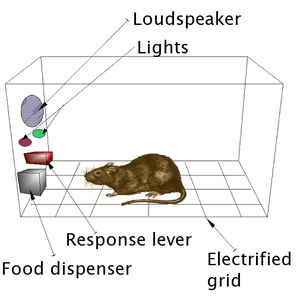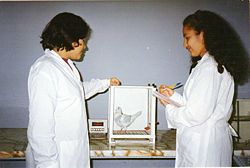- Operant conditioning chamber
-
An operant conditioning chamber (also known as the Skinner box) is a laboratory apparatus used in the experimental analysis of behavior to study animal behavior. The operant conditioning chamber was created by B. F. Skinner while he was a graduate student at Harvard University (Masters in 1930 and doctorate in 1931). It is used to study both operant conditioning and classical conditioning.[1]
Contents
Purpose
An operant conditioning is done by applying a principle called Law of Effect, when a behavior has good consequences, it will tend to be repeated by the subject while bad consequences will tend to be not repeated. An operant conditioning chamber permits experimenters to study behavior conditioning (training) by teaching a subject animal to perform certain actions (like pressing a lever) in response to specific stimuli, like a light or sound signal. When the subject correctly performs the behavior, the chamber mechanism delivers food or another reward. In some cases, the mechanism delivers a punishment for incorrect or missing responses. With this apparatus, experimenters perform studies in conditioning and training through reward/punishment mechanisms.
Structure
The structure forming the shell of a chamber is a box large enough to easily accommodate the organism being used as a subject. (Commonly used model organisms include rodents—usually lab rats—pigeons, and primates). It is often sound-proof and light-proof to avoid distracting stimuli.
Operant chambers have at least one operandum (or "manipulandum"), and often two or more, that can automatically detect the occurrence of a behavioral response or action. Typical operanda for primates and rats are response levers; if the subject presses the lever, the opposite end moves and closes a switch that is monitored by a computer or other programmed device. Typical operanda for pigeons and other birds are response keys with a switch that closes if the bird pecks at the key with sufficient force. The other minimal requirement of a conditioning chamber is that it has a means of delivering a primary reinforcer or unconditioned stimulus like food (usually pellets) or water. It can also register the delivery of a conditioned reinforcer, such as an LED (see Jackson & Hackenberg 1996 in the Journal of the Experimental Analysis of Behavior for example) signal as a "token".
Despite such a simple configuration, one operandum and one feeder, it is possible to investigate many psychological phenomena. Modern operant conditioning chambers typically have many operanda, like many response levers, two or more feeders, and a variety of devices capable of generating many stimuli, including lights, sounds, music, figures, and drawings. Some configurations use an LCD panel for the computer generation of a variety of visual stimuli.
Operant chambers can also have electrified nets or floors so that electrical charges can be given to the animals; or lights of different colors that give information about when the food is available. Although the use of shock is not unheard of, approval may be needed in some countries to avoid unnecessary harmful experimentation on animals. Skinner's work did not focus on punishment, and involved a "paw slap" which caused him to conclude, incorrectly, that punishment was ineffective. Works by Azrin, Sidman and others in the 1960s and 1970s showed this was not the case.
Research impact
Skinner's operant chamber allowed him to explore the rate of response as a dependent variable, as well as develop his theory of schedules of reinforcement. If the event increased the number of responses it is said to strengthen its responding and if it decreased the number of responses it weakens the responding. The first operant chambers were attached to cumulative records on drums producing characteristic pauses, scallops, and other lines. Operant conditioning chambers have become common in a variety of research disciplines including behavioral pharmacology, and whose results inform many disciplines outside of psychology such as behavioral economics.
Application to Games
Slot machines and online games are sometimes cited[2][3] as examples of human devices that use sophisticated operant schedules of reinforcement to reward repetitive actions.[4] However, others have also critiqued the application of skinner boxes to game design as incomplete and uninformed by an understanding of evolutionary psychology.[5]
Skinner Box
Skinner is noted to have said that he didn't want to be an eponym.[6] The term Skinner Box is considered by some[who?] to be pejorative, and is probably most commonly used by those who are not in the discipline of Experimental analysis of behavior or in psychology[citation needed].
See also
References
- ^ R.Carlson, Neil (2009). Psychology-the science of behavior. U.S: Pearson Education Canada; 4th edition. pp. 207. ISBN 9780205645244.
- ^ Hopson, J. (April 2001). "Behavioral game design". Gamasutra. http://scholar.google.com/scholar?q=Behavioral+Game+Design.
- ^ Extra Credits (November 2010). "The Skinner Box". Escapist Magazine. http://www.escapistmagazine.com/videos/view/extra-credits/2487-The-Skinner-Box.
- ^ Dennis Coon (2005). Psychology: A modular approach to mind and behavior. Thomson Wadsworth. pp. 278–279. ISBN 0534605931. http://books.google.com/books?id=018X76Gn_T0C&pg=PA278&lpg=PA278.
- ^ Jon Radoff (2011). "Gamification, Behaviorism and Bullsh$!". Radoff.com. http://radoff.com/blog/2011/08/09/gamification-behaviorism-bullshit/.
- ^ Skinner, B. F. (1959). Cumulative record (1999 definitive ed.). Cambridge, MA: B.F. Skinner Foundation. p 620
External links
- From Pavlov to Skinner Box - background and experiment
Categories:- Laboratory equipment
- Behaviorism
- Behavioral neuroscience
- Learning
Wikimedia Foundation. 2010.



